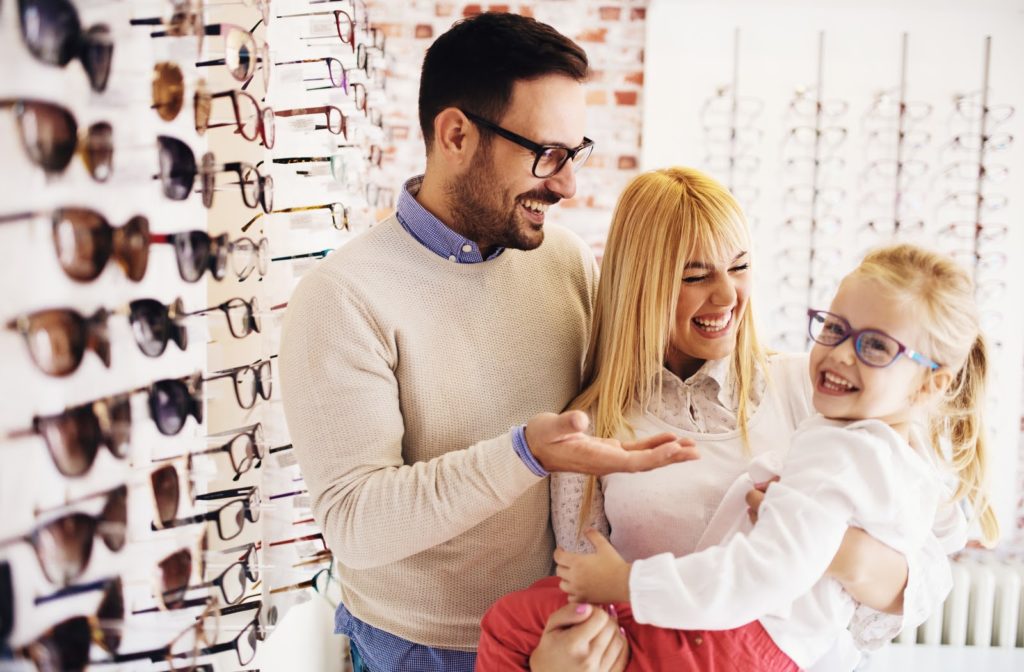Proper development of healthy eyes at a young age greatly impacts your child’s ability to grow and learn. Knowing the signs that indicate that your child may need glasses is important, and if you suspect your child is having problems with their eyesight, it is imperative to book an eye exam for them as soon as possible. If any problems with your child’s eyes go undiagnosed, it can greatly impact their ability to learn at school and will affect the quality of their eyesight later on in life.
1. Squinting Eyes and Tilting Head
If you find your child is often squinting or tilting their head when they are looking at things far away, it may be a sign that they have myopia (nearsightedness). If myopia is diagnosed early on in a child’s life, a few effective control measures can be taken to lessen its effects. Some of the measures include atropine eye drops, and specialty myopia control glasses or contact lenses.
2. Excessive Tearing
Excessive tearing can be an indication that one or both of your child’s eyes are being overworked, or their eyes might have some infection or damage. This issue can also stem from blocked tear ducts; to properly diagnose what your child is experiencing you must bring them in for an eye exam so an optometrist can make an accurate assessment of your child’s eyes and give a recommendation for what type of solution is the most effective.
3. Rubbing Eyes and Eye Fatigue
If your child is always rubbing their eyes or complaining about how their eyes hurt, it may be indicative of a need for glasses. These conditions are often a product of refractive issues and may signify that your child has astigmatism, nearsightedness, or farsightedness. Your child’s eyes are working too hard to see in some specific setting, and it is important for them to get diagnosed during an eye exam to understand the exact condition they are facing.
4. Covering One Eye to See
This might indicate that your child sees better out of one eye compared to the other. Your child may have amblyopia (lazy eye) or astigmatism in one eye. These conditions can range from severe to almost negligible, so it is a good idea to book an eye exam for your child to see if they need glasses as a correctional measure for their eyesight. An easy way to tell which eye your child is having trouble with is by covering each of their eyes one at a time then asking them what they can see and which eye sees more clearly.
5. Extreme Light Sensitivity and Headaches
This issue can arise due to your child being photophobic (sensitive to light). Special eyeglass lenses and sunglasses can be used to reduce the severity of your child’s sensitivity to light, and help them see more clearly in bright conditions. If your child is getting headaches when they are outside for some time, this can be a sign that they are photophobic.
6. Using a Finger to Read
If your child is a bit older and is still using their finger to follow along while reading, it could be a sign that they have amblyopia. Ask your child to try reading without their finger, and if they continuously get lost in the text, then you should consider whether or not they need corrective eyeglasses.
7. Losing Their Place While Reading
Astigmatism and strabismus (crossed eyes) can be the root cause of your child losing their place while reading. If your child signifies to you that they cannot make sense of what is on a page or says that the text gets distorted or blurry, this can be an indication that they need glasses. Getting your child to read aloud to you can be a great way to build up their literacy skills, but also gives you a chance to monitor their eyesight and ability to read text.

8. Sitting Very Close to Screens
If your child needs to view screens very close to see them clearly or needs to get very close to text to read it, it can be another sign that they have myopia. Being too close to digital screens can have a detrimental effect on eyesight at an early age, and eyeglasses should be considered to alleviate the issues your child is having with myopia.
9. Complaining About Blurry Vision at Certain Distances
This may be the most obvious sign that your child needs eyeglasses, as they are directly confirming that they are having some sort of issue with their eyesight. They may be nearsighted or farsighted if the distance they can see clearly is the common issue. If one or both eyes are blurry all the time, it may indicate that they have astigmatism or some sort of damage to their eyes has affected their ability to see.
10. Performance in School
Your child may be having difficulties in school due to not being able to see the information on computers and whiteboards. Most often it is an issue dealing with nearsightedness, but other ailments such as color blindness may be the cause of their impaired vision. Ask your child if they think reading the information on a whiteboard is hard, and ask them where they sit relative to the board in their classroom. This will give you an indication of the eyesight issue that might be prevalent.
What Should You Do if You Think Your Child Needs Glasses?
If your child is exhibiting any of these 10 things, it is a good idea to book an appointment to see if they need corrective eyeglasses or contact lenses. We will be able to accurately diagnose your child and get them the most effective corrective eyewear to suit their needs.



